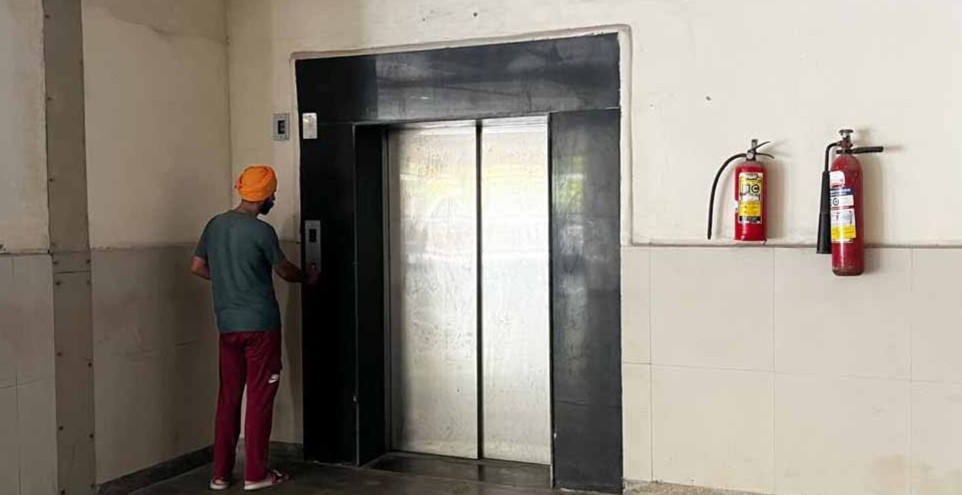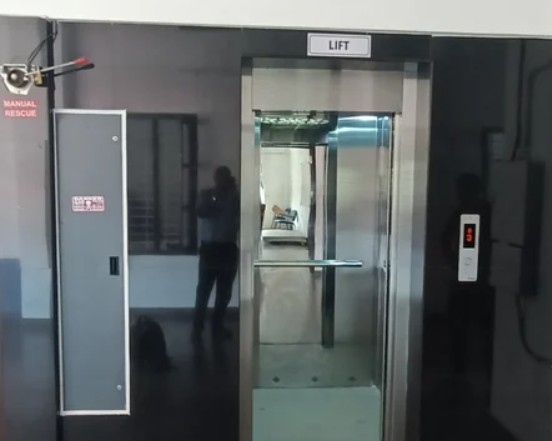In a development that has stirred concern among patients and staff alike, the main lift at a prominent government hospital has been officially declared non-operational for the next two months due to essential repair and maintenance work. The closure, which comes as part of a planned renovation initiative aimed at enhancing safety and efficiency within hospital infrastructure, has left patients, particularly the elderly and those with mobility issues, facing significant inconvenience.
The announcement was made earlier this week by hospital authorities, who confirmed that the aging lift had shown repeated technical faults in recent months. “There have been multiple complaints from patients and staff regarding the lift’s performance,” an official from the hospital administration said. “After consultation with the Public Works Department and a detailed technical inspection, it was found that the lift’s core mechanisms, including the motor and shaft systems, required a complete overhaul. For the safety of everyone, we had no choice but to shut it down for thorough servicing and replacement of key parts.”
The hospital, a lifeline for hundreds of patients every day, particularly from economically weaker sections, relies heavily on the lift system, especially for transporting patients from the emergency unit and outpatient departments to upper-level wards. The closure has placed a strain on hospital operations, forcing both medical personnel and patients to use the staircase, often resulting in delays, discomfort, and occasional medical risks.
Among those hardest hit are senior citizens, pregnant women, and patients recovering from surgery. Sixty-five-year-old Surinder Kaur, who visited the hospital for her weekly check-up, found it difficult to climb three flights of stairs with her walker. “It took me over fifteen minutes just to get to the doctor’s room. I had to stop several times because of breathlessness,” she said. “They should have made alternative arrangements for people like us.”

Hospital staff members are trying their best to assist, but the volume of patients far exceeds the available manpower. Attendants and security guards are frequently seen helping carry wheelchairs up the stairs or guiding patients through alternate, but still inconvenient, routes.
Doctors have also voiced their concerns. One of the senior consultants in the internal medicine department stated, “We understand the importance of maintenance, but the hospital should have planned this better. There should have been a temporary lift or even ramps constructed for easy access. Many of our patients are suffering unnecessarily.”
Hospital authorities are aware of the impact and insist that measures are being taken to ease the burden during the repair period. “We are arranging for additional wheelchairs and assigning more support staff to assist patients with movement,” said the hospital’s superintendent. “We understand the discomfort, but this maintenance is long overdue. It is being done to ensure the long-term safety and functionality of the lift, which has been serving beyond its operational age.”
According to the detailed statement from the PWD, the repair project involves dismantling the existing lift components, replacing the control panel, refurbishing the lift cabin, and ensuring compliance with modern safety standards. Engineers anticipate that the process will take approximately 60 days, barring unforeseen technical challenges. The lift will also be outfitted with a new power backup system and emergency alarm functions for future contingencies.
While the upgrade is appreciated in principle, patients’ rights groups and civil society members argue that the hospital should have communicated the plan earlier and more transparently. “There are many who come from rural areas, unaware of this closure, and arrive only to find themselves in distress,” said Jaspreet Singh, a local activist who works with patient welfare NGOs. “It’s important that public institutions handle such disruptions with empathy and proactive communication.”
Meanwhile, the hospital administration has placed notices across the premises, warning of the temporary shutdown and advising patients to plan accordingly. Volunteers are being deployed to help elderly and disabled patients navigate the building. A separate helpdesk has also been set up to handle complaints and coordinate assistance.
In the long run, officials hope that the upgraded lift will significantly improve hospital logistics and patient care. They have promised that once installed, the lift will operate with better reliability and capacity to handle emergency loads. However, this does little to alleviate the ongoing struggle patients and staff will endure over the next two months.
Some have suggested that the government consider installing an additional lift in the hospital premises to avoid future disruption. “With the footfall this hospital sees, there should be a contingency plan or a secondary lift,” said a nurse who works in the maternity ward. “It’s very difficult when both the staff and the patients are relying on just one means of vertical transport.”
In the past, similar maintenance operations in other government facilities have taken longer than the announced timelines, which raises skepticism about whether this project will truly be completed within two months. Nevertheless, the hospital’s engineering team is reportedly working round the clock to expedite the process.
The issue has also drawn attention at the municipal level, with a few local councillors raising the matter in civic meetings and urging faster execution of the work. Some political leaders have promised to monitor the progress and ensure that patients are not left to suffer in silence.
In the meantime, many are forced to adapt, showing resilience in the face of adversity. Hospital visitors, attendants, and medical professionals alike are developing informal systems of support, from physically helping patients up the stairs to organizing small rest stops between floors for those who need a break. It is a testament to the spirit of community that exists even in the often-overwhelmed corridors of public healthcare.
As the hospital marches through this challenging period, all eyes will be on the administration and engineering teams to ensure timely delivery and minimal inconvenience. While the goal of better infrastructure is laudable, the path to it, especially in healthcare, must always place patient comfort and dignity at the center.


